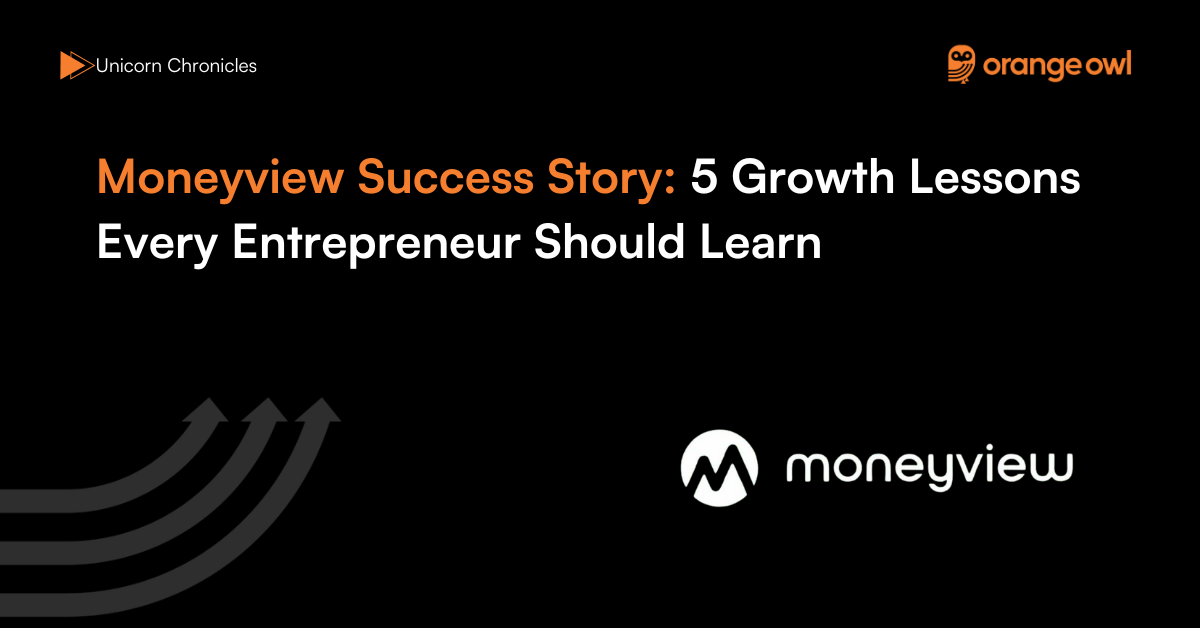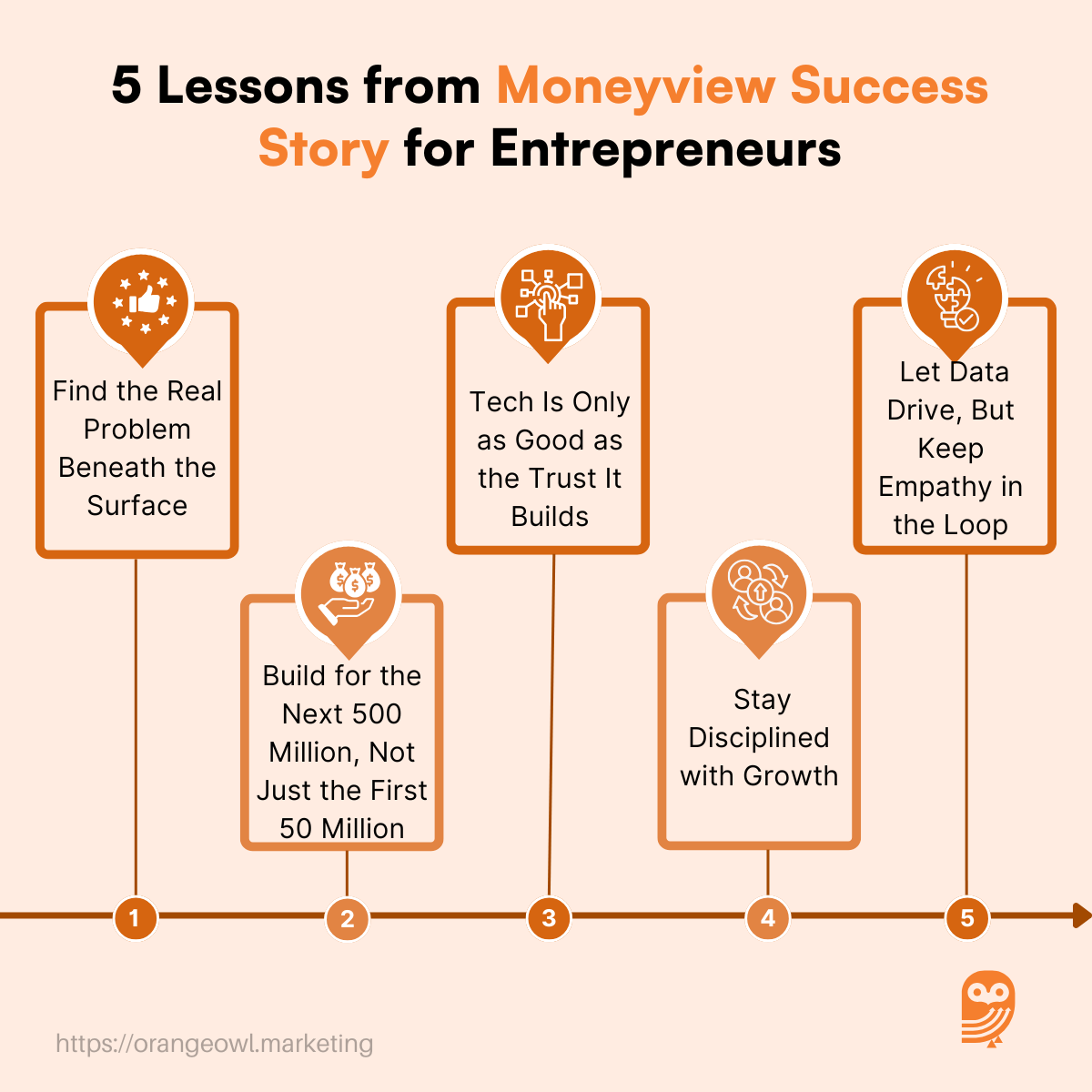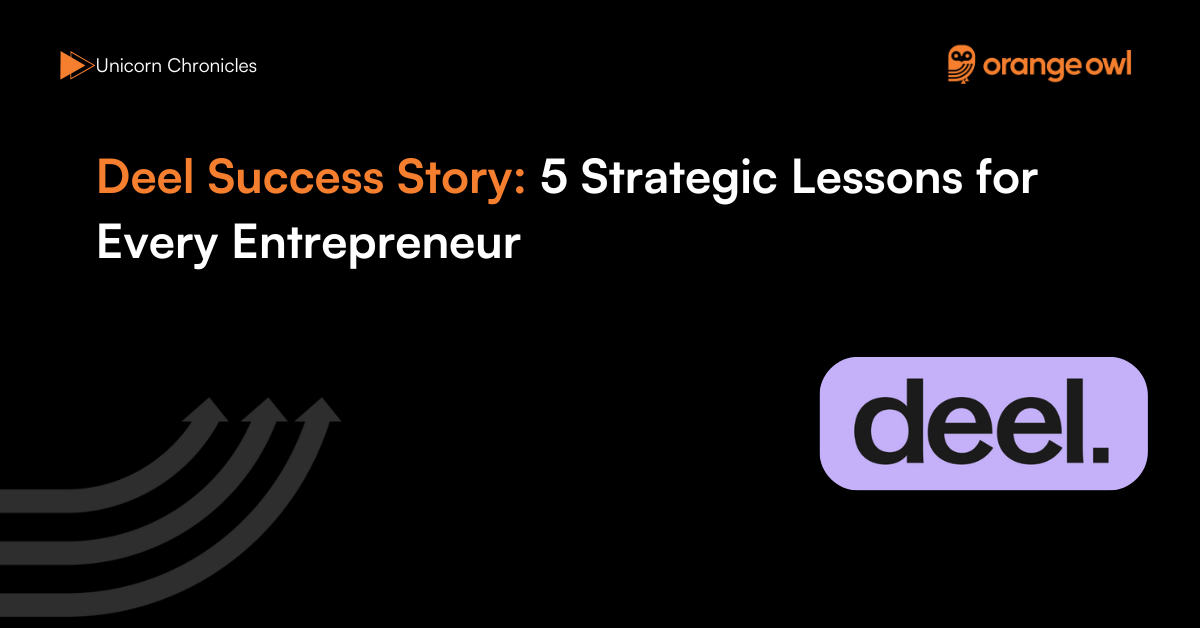Moneyview Success Story: 5 Growth Lessons Every Entrepreneur Should Learn
Vivek Goel
May 6, 2025

Table of Contents
Introduction
In the ever-evolving landscape of Indian fintech, Moneyview has emerged as a trailblazer in digital lending. Founded in 2014 by Puneet Agarwal and Sanjay Aggarwal, the company began as a personal finance management app. Recognizing a significant gap in access to formal credit for underserved individuals, Moneyview pivoted to address this pressing issue. Their journey from a budgeting tool to one of India’s leading lending platforms exemplifies strategic evolution, deep user empathy, and technological excellence.
“The real India doesn’t have a CIBIL score. We wanted to serve that Bharat.” — Puneet Agarwal
As of 2024, Moneyview boasts over 45 million app downloads and has disbursed loans exceeding ₹12,000 crore, reaching users across more than 19,000 locations in India. The platform serves a vast user base of 200 million across 200 cities, with 75% of its users hailing from Tier II and III cities.
In September 2024, Moneyview achieved unicorn status, attaining a valuation of approximately $1.2 billion. This milestone was bolstered by the acquisition of employee benefit startup Jify, expanding Moneyview’s financial services portfolio.
Financially, Moneyview reported a 75% increase in operating revenue, reaching INR 1,012 crore in FY24, up from INR 577 crore in the previous fiscal year. The company’s net profit also saw a modest rise of 5.2%, totaling INR 171.15 crore.
Moneyview’s success underscores the potential of fintech solutions tailored to the unique needs of India’s diverse population, particularly those in underserved regions.
Origin Story
Moneyview was founded in 2014 by IIT alumni Puneet Agarwal and Sanjay Aggarwal, born out of a simple yet powerful mission—to enhance financial awareness and empower individuals to take control of their money. Initially launched as a personal finance management app, Moneyview helped users track expenses, categorize spending, and stay on budget. But as the founders engaged deeply with their user base, a surprising pattern emerged.
Most users weren’t just struggling to manage money—they were fundamentally excluded from India’s formal credit system. Despite the rise of digital banking and UPI, millions of Indians, especially in Tier 2 and Tier 3 cities, had little to no access to personal loans. This insight sparked a radical pivot.
“Most Indians don’t want to track their expenses—they want credit. That’s when the shift happened.” — Sanjay Aggarwal, Co-founder, Moneyview
Recognizing this unmet demand, Moneyview transitioned from being a budgeting app to a full-stack digital lender. But they didn’t take the conventional path. Instead of relying on credit bureau scores like CIBIL, which excluded millions of “thin file” users, Moneyview built proprietary credit models. They leveraged alternative data sources—like smartphone metadata, SMS alerts from banks, and transactional behavior—to evaluate creditworthiness.
This shift was not just innovative; it was inclusive. It enabled the company to lend responsibly to first-time borrowers, gig workers, and semi-formal economy participants who had historically been invisible to traditional banks.
Business Landscape and Early Challenges
Moneyview’s transition into digital lending placed it in one of the most challenging segments of India’s fintech ecosystem. While the opportunity was massive—an estimated 190 million Indians lack access to formal credit—the barriers to entry were equally high. Regulatory compliance, trust-building, and risk management were just the beginning.
“The biggest challenge was convincing partners and investors that creditworthy users existed outside credit bureaus.” — Puneet Agarwal, Co-founder, Moneyview
Unlike legacy financial institutions, which focused heavily on urban, salaried customers, Moneyview took a data-first, Bharat-focused approach. But this came with its own risks. Convincing NBFC partners, regulators, and even early-stage investors required the founders to demonstrate not just the need, but also the viability of lending to financially underserved populations.
The company adopted a disciplined approach to growth. Rather than offering easy credit and burning cash to acquire users, Moneyview emphasized sustainable lending practices. They spent years refining their AI-powered risk engine, optimizing for unit economics, and ensuring that loans could be repaid on time.
Even during turbulent periods like COVID-19, when many lenders tightened credit lines, Moneyview’s robust underwriting model allowed it to continue operations with caution and resilience. This long-term vision helped the company build trust, retain partners, and survive multiple funding winters—something not all fintechs managed to do.
By staying focused on fundamentals—responsibility, compliance, and customer-centricity—Moneyview laid a strong foundation for exponential growth in later years.
Growth Strategies
The rise of Moneyview is a masterclass in building a tech-driven, inclusive financial ecosystem. Unlike traditional lenders who focused on salaried, urban populations with CIBIL scores, Moneyview honed in on “credit invisibles”—millions of Indians with no formal borrowing history. This untapped demographic became the company’s core growth engine.
At the heart of this growth was alternative credit scoring. Using advanced data science, the team engineered a proprietary credit model that could evaluate risk using non-traditional signals—including smartphone metadata, SMS-based banking alerts, cash inflows, utility payments, and app usage behavior. This allowed them to lend to gig workers, self-employed individuals, and those outside the formal banking grid.
“We built the product for middle India. It had to work on a 4G phone in a small town, without jargon.” — Sanjay Aggarwal, Co-founder, Moneyview
The platform offered 100% paperless loans, ranging from ₹5,000 to ₹5,00,000, with flexible repayment tenures from 3 to 60 months. The end-to-end journey—from application to disbursal—could be completed in minutes through a mobile device, even in areas with poor internet infrastructure. This mobile-first architecture helped Moneyview reach customers across Tier 2, Tier 3, and rural regions.
By 2023, Moneyview had disbursed over ₹10,000 crore in personal loans,, and its app had been downloaded over 40 million times on the Google Play Store—making it one of the most trusted digital lenders in India.
In December 2022, the company raised $75 million in Series E funding from Tiger Global, Winter Capital, Accel, and Evolvence India, pushing its valuation to $900 million. By early 2023, it officially entered India’s unicorn club, joining the ranks of leading fintech innovators.
But even with such scale, Moneyview remained disciplined. They prioritized profitability over blind growth, maintained a sharp focus on unit economics, and continued to enhance their risk models to avoid defaults.
Marketing Strategies
Moneyview’s marketing journey didn’t rely on celebrity endorsements or splashy TV commercials. Instead, the company built its brand on transparency, simplicity, and relatability—speaking directly to the pain points of underserved borrowers.
The bulk of their user acquisition came through performance marketing on Google, Facebook, and app discovery platforms. They created region-specific creatives in vernacular languages, ensuring cultural and linguistic relevance for audiences across India. Campaigns highlighted clear messages—“no hidden charges,” “quick approval,” “low documentation”—building instant trust.
What truly set Moneyview apart was its focus on financial education. Through the app and blog, they published easy-to-understand content on EMI planning, credit health, budgeting, and financial discipline. This not only empowered users but also improved repayment behavior and customer loyalty.
“Our mission wasn’t just to lend, but to uplift. Financial literacy is key to long-term impact.” — Puneet Agarwal, Co-founder, Moneyview
Their user interface was deliberately designed to feel non-intimidating—no complex forms, no banking jargon. Even a first-time borrower from a Tier 3 town could complete a loan application without friction. This emphasis on user experience led to a high Google Play rating (4.4+ as of 2024) and strong repeat usage metrics.
Strategic partnerships also played a role. By integrating with NBFCs, digital wallets, and consumer tech platforms, Moneyview embedded lending in users’ natural digital journeys—whether they were shopping, paying bills, or booking services online.
This combination of tech-driven personalization, grassroots marketing, and educational empowerment helped Moneyview become a trusted household name in digital lending.
5 Growth Lessons Every Entrepreneur Should Learn from Moneyview
1. Find the Real Problem Beneath the Surface
Moneyview’s original mission was to improve financial literacy and help people track their spending. But as the founders dug deeper into user behavior, a clearer insight emerged: people didn’t just want to manage money—they needed access to it. Most users were struggling not with planning expenses, but with a lack of formal credit.
This crucial understanding led to a bold pivot—from being a passive money management tool to an active credit provider for underserved India. That shift laid the foundation for their unicorn success.
“Pivoting isn’t failure. It’s responding to what your users truly need.”
— Puneet Agarwal, Co-founder, Moneyview
Entrepreneurial takeaway: Don’t fall in love with your original product. Fall in love with your users’ problems. Build what they actually need, not just what you intended.
2. Build for the Next 500 Million, Not Just the First 50 Million
While many startups were focused on India’s English-speaking, urban elite, Moneyview chose a more ambitious path. They targeted the “Bharat” market—people in Tier 2, Tier 3, and rural regions who were often invisible to banks and credit bureaus.
This meant creating a product that could run on low-end smartphones, work with patchy internet, and support regional languages. It also required building trust with users unfamiliar with formal finance or digital lending.
“We built the product for middle India. It had to work on a 4G phone in a small town, without jargon.”— Sanjay Aggarwal, Co-founder, Moneyview
Entrepreneurial takeaway: Scale doesn’t come from the elite—it comes from the masses. If you want to build a big business in India, make it work for the majority.

3. Tech Is Only as Good as the Trust It Builds
In fintech, speed and scale are important—but nothing matters more than trust. Moneyview knew that handling people’s money required transparency, data security, and regulatory compliance from day one.
They built secure APIs, adhered to strict RBI norms, and partnered only with NBFCs that met ethical lending standards. Their app was also crystal clear about loan terms, interest rates, and repayment policies—reducing fear and friction for first-time borrowers.
Entrepreneurial takeaway: Trust is your most valuable currency—especially in finance, health, and other high-stakes domains. Tech should simplify and secure, not confuse or manipulate.
4. Stay Disciplined with Growth
While many startups were burning cash to acquire users and inflate metrics, Moneyview stayed laser-focused on profitability. They avoided vanity KPIs and built a business with strong unit economics, where each customer added to—not drained—the bottom line.
Even during India’s fintech funding winter, Moneyview stood out for its sustainable model. By resisting the pressure to expand recklessly, they built a resilient company that investors and customers could believe in.
Entrepreneurial takeaway: Growth without discipline leads to burnout—financially and operationally. Long-term success comes from building a business, not just raising funds.
5. Let Data Drive, But Keep Empathy in the Loop
Moneyview’s risk engine is built on sophisticated data science. It can assess creditworthiness using smartphone metadata, transaction alerts, and behavioral patterns. But what truly sets them apart is their empathy-first approach.
From their friendly app interface to their educational content and non-predatory loan terms, Moneyview treats users as partners, not just data points. They understand that behind every loan is a real person facing a real financial need.
“Our mission wasn’t just to lend, but to uplift. Financial literacy is key to long-term impact.” — Puneet Agarwal
Entrepreneurial takeaway: Algorithms can guide decisions, but empathy builds loyalty. The best products combine precision with compassion.
Conclusion: Key Takeaways from Moneyview’s Journey
Moneyview isn’t just a fintech success story—it’s a masterclass in building a business rooted in purpose, empathy, and precision execution. From launching as a simple personal finance app in 2014 to becoming a $1 billion digital lending unicorn in under a decade, Moneyview’s evolution showcases the power of listening to users and solving real problems with long-term intent.
“We don’t just give loans—we build trust, credit history, and dignity.” — Sanjay Aggarwal, Co-founder, Moneyview
Their success wasn’t built on flashy campaigns or high-risk bets—it came from deeply understanding the credit gap in middle India, developing responsible underwriting models, and earning user trust over time. They chose to focus on underserved demographics, rejected predatory growth, and created a tech product that could thrive in low-connectivity, low-trust environments.


